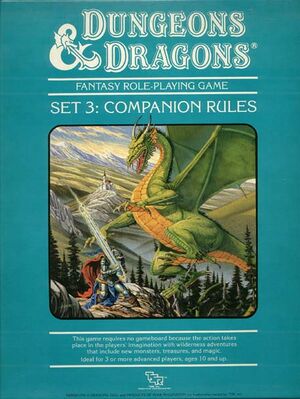Companion Set
| This article or section is about something oldschool - and awesome. Make sure your rose-tinted glasses are on nice and tight, and prepare for a lovely walk down nostalgia lane. |

The Companion Set, or Companion Rules, are the high-level rules in the Tom Moldvay spinoff of the original Not-Advanced D&D rules. They kick in where the Expert rules taper off, 15th level by the charts but read-ahead parties might consider 9th in parts. Frank Mentzer, after a thorough retcon of Basic and Expert, put this out around 1983ish.
The player-characters and their enemies got some new weapons, like the bastard sword that can be used onehanded or twohanded to kill Kenny. Also the blackjack / sap for the Thief (mostly) to knock out an unhelmeted sentry; and the bola, to trip up foes from a distance.
Also brought to the table are proto-Prestige classes, basically. Your Lawful Fighter can be a Paladin, your Chaotic Fighter a sort of anti-paladin named an Avenger, Neutral Cleric a Druid, etc.
Also also here: some way for the Elf and other demihumans to keep progressing along with the humans - the Attack Rank. These are alphabet-levels, for fighting-ability only, in lieu of numeric-levels. And the demihumans each get a MacGuffin artifact to form the core of their lairs: Tree of Life, Forge of Power, and (for the wee folk) the Crucible of Blackflame. Again... not every idea here is perfect.
The targeted levels overlap high-end AD&D's, so the core content presents 1970s-era mainstays to 1980s-era players. Those fifth-and sixth-tier Moldvay spells which Mentzer had suppressed, are, herein, restored: Contact Higher Plane, Feeblemind, Telekinesis, Control Weather, Reincarnation. At 15th level come the seventh and eighth level tiers, where mages really start to kick some ass: Power Words, bitchez.
This Set goes like the Basic, against Expert; it has its own DM book. There - finally - the party will meet the Ghost and the Beholder. (Tho' not yet the Lich. Nor any demons despite the teasing of Planes.) Also here are some high-ish difficulty monsters mooted out and about in the Expert line, mostly from X5.
We do have to hit the editors for klutzing up the alphabetic order of the monsters however, including - laughably - X2's gremlin. And the undead here are overstuffed: we didn't ask for a Phantom / Haunt division of six (6) all-incorporeal undead, and then the box offered three more Spirit-level undead interacting (with no explanation) with corporeal matter (does it animate this matter?). The AD&D crew gave up trying to read Mentzer's mind so you won't be seeing much of it in future editions. (Unless the third-edition bhut is a Spirit-in-disguise...)
The DMs' book includes two "mini adventures" that are little more than single-combat setpieces. One is a tournament featuring a knight named Sir Guy de Gax; the other, a pit-fighting arena that forbids spellcasting. Recommend inviting Statler and Waldorf to both.
At 15th level on up, really 9th on up, the PCs should be considering doing a Conan and ruling domains of their own, delegating other - lowlevel - adventurers to do grunt work like goblin hunting. There are some brilliant ideas in the Companion DM section on what PCs can do in the meantime; most salient, that domain-ruling mechanic (better keep that Confidence Level high, folks!) and also the WAAAGH Machine, sort of a "Take Two" for old Chainmail. Although the 'Machine was somewhat Strategic for tactical tabletop gamers' tastes, so BATTLESYSTEM would serve that latter niche.
Beyond 25th level, PCs would be moving on from Mature to (what we're going to call) Epic, so the Master's rules kick in after that.
We don't know why, but the Players book is where to find the map of continent Brun. This has rectangles around the places we've been: X1: the Isle of Dread, X4 and X5 from the Desert Nomads (so far) duology, X6: Quagmire!, and - sneakpeek - CM1: Test of the Warlords. X9: Savage Coast and X11: Saga of the Shadow Lord didn't exist yet. Let's all pretend X11 still doesn't.
The modules in this system began CM-. Some of them are good, although it all starts out as a bare showcase for the system.
Overall, the Companion Rules were awesome, or at least formed a serious competitor for high-level AD&D. Their Set both scaled better than AD&D 1e and provided some large-scale heroics for parties beyond just bashing skulls.